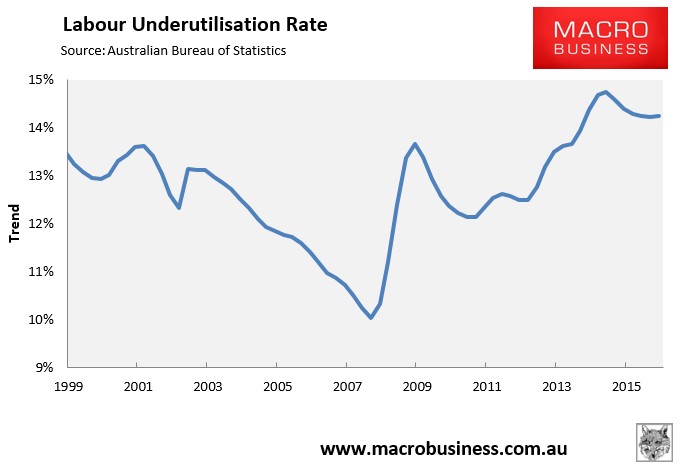The growth lobby often argues that Australia needs to run high levels of immigration in order to alleviate so-called skills shortages and to mitigate an ageing population.
This view has been debunked many times on this blog.
First, analysis from the Department of Employment shows that Australia’s skills shortage “remains low by historical standards”.
Second, there are big question marks over whether immigration can alleviate skills shortages anyway?
That is, if Australia imports a whole bunch of workers to alleviate, say, shortages in construction, these workers will inevitably increase demand in other areas (e.g. for various services), thus creating shortages there. Australia could then import a whole bunch of workers to alleviate shortages in these areas, but then they will increase demand for housing and infrastructure, thus increasing shortages for construction workers. Dog meet tail.
The sustainable solution, of course, is to better utilise Australia’s existing workforce, where spare capacity is at high levels (see next chart).

Third, worries about Australia running out of workers due to an ageing population are misguided given the rise of robotics and artificial intelligence, which threatens to replace many of today’s jobs.
Indeed, Department of Industry Modelling previously forecast that 500,000 Australian jobs are at risk as automation, robots and artificial intelligence swallows accountants, supermarket cashiers, secretaries, typists and bank tellers, amongst other professions.
KPMG’s Bernard Salt has also estimated that up to half of Australian jobs could be at risk from digitisation, and warned that that technological change could mean there will too few jobs to go around in the future.
Another recent report, entitled When robots and AI come, what jobs will be left?, argued that in 100 years, only 10% to 20% of us will actually work as robots take over.
These reports followed similar warnings from The Economist and The Atlantic that increasing automation, computerisation and artificial intelligence could place at risk half of current jobs in the United States within a decade or two. Other reports have made similar observations (see here and here).
Yesterday, The AFR published an interesting case study on Singapore, which is already turning to machines to mitigate a rapidly ageing population and worker shortages:
Singapore’s latest quest to boost productivity is playing out at a busy food court in the second terminal of Changi Airport.
There, hungry passengers can select their chicken rice or bowl of noodles from a machine, pay with a credit card and collect their food — all with minimal human interaction and in stark contrast with the abundant manpower commonly used in food courts elsewhere on the island.
It’s this kind of automated initiative that’s popping up more frequently across Singapore — from self-driving taxis to face-reading payment systems for rail commuters — as the city state grapples with a rapidly aging population, falling fertility rates and a slump in economic growth.
With authorities restricting the inflow of foreign workers after a backlash against immigration, Singapore is increasingly turning to machines to replace low-end manpower…
“Other countries have population trends more in their favour, so they have less pressure to drive productivity. That’s why Singapore is doing what it’s doing”…
The food industry is one of 23 that the government has identified as part of a S$4.5 billion, five-year transformation plan to help companies optimise the use of manpower.
Australia has already experienced a taste of automation across its major supermarkets, where self-service checkouts have replaced manned checkouts. And it is easy to see to world moving towards the Singaporean model as technology improves and nations’ populations age.
In any event, the whole ‘rise of the machines’ does debunk the claim that Australia needs to import large swathes of skilled workers to overcome an ageing population.
The reality is likely to be the opposite: too many workers chasing too few jobs as robots and artificial intelligence take over. So why, then, is Australia running one of the highest immigration programs in the world, especially given the extreme pressure that it is placing on infrastructure, housing, schools, hospitals and overall livability?

